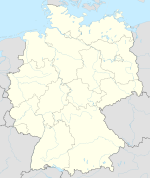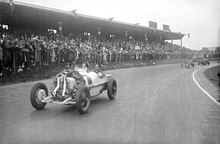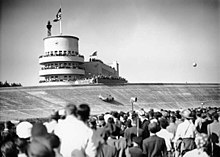AVUS
|
|
|
|
|
|
||
| Route type: | Former racetrack | |
|---|---|---|
| Opening: | September 24, 1921 | |
Formula 1 venue : |
1959 |
|
| Decommissioned: | April 26, 1998 | |
| Track layout | ||
|
Course of the race track: 1 - south loop 2 - departure to the north loop 3 - north curve 4 - start and finish line |
||
| Route data | ||
| Important events: |
Formula 1 , DTM | |
| Route length: | 8.3 km (5.16 mi ) | |
| Curves: | 4th | |
| Curve superelevation: | 1937-1967: north curve 43.6 ° | |
| Records | ||
| Track record: (Formula 1) |
2: 04.5 min. ( Tony Brooks , Ferrari , 1959) |
|
Coordinates: 52 ° 28 ′ 50 ″ N , 13 ° 15 ′ 5 ″ E

The AVUS (Automobile Traffic and Exercise Road) is located in the southwest of Berlin and is the northern section of the A 115 motorway . When it opened in 1921, the AVUS was the world's first exclusive road . The 8.3 km long and toll-based route served as a racing and test track and not for public transport until 1940 .
The AVUS leads from the radio tower , where it has a connection to the Berlin city ring (A 100), about nine kilometers straight through the Grunewald to Nikolassee . Until April 1998, the AVUS was also used as a race track on certain weekends.
history
Motivated by German failures at automobile sport events, Automobil-Verkehrs- und Übungsstraße GmbH was founded in 1909 with the aim of promoting the competitiveness of the German automobile industry. After conversion into a stock corporation, work began in 1913 on a road only permitted for cars along the Wetzlarer Bahn from Charlottenburg to Nikolassee .
Because of the First World War , the work was stopped shortly before completion in 1914. It was not until 1921 that the race track was completed through private investments by Hugo Stinnes and opened on September 24, 1921. The almost straight race track connected the north curve in Westend (in what was then the district of Charlottenburg ) with the south curve on Nikolassee to create a 19-kilometer circuit. After the opening, the route was opened to private traffic. A one-time trip cost the then impressive sum of ten marks , a quarterly ticket cost 1,000 marks.
Already at the opening race, deficits of the route that could be traced back to a lack of experience in building the lane became apparent. The macadam structure from the 19th century was still soaked with tar, but could not withstand the increasing loads, so that the AVUS was one of the first roads to be covered with an asphalt layer . In the following years, parts of the AVUS were dismantled by the population and sold or burned due to the economic hardship associated with inflation .
In 1926 , with the first German Grand Prix, another major car race took place, with four fatalities due to adverse weather conditions and the poor condition of the track. In addition to the poor grip of the surface, the route had bumps of up to ten centimeters in height due to the traditional road structure with insufficient compaction of the ground. In the following years, the AVUS became a test track for road construction, on which many elements of today's road construction were tested for the first time.
Racing largely came to a standstill as a result of a sales crisis in the German automotive industry in the mid-1920s and the global economic crisis that began in 1929 . It was not regularly resumed until the early 1930s.
In order to increase the lap speeds and to gain space for today's Halenseestrasse, the old north curve was replaced in 1937, on the initiative of building councilor Erich Krey , by an elevated, 43.6 ° steep, brick- walled steep curve with a significantly smaller radius and that now on the other side of the Halenseestrasse, the administration building with the spectator stand through a new building with a judge tower at the exit of the north curve. This is now used as a motel . At the same time, a new grandstand was built.
The connection to the Berliner Ring was opened to traffic in 1940, whereby the AVUS lost its private road character as a feeder. The south curve on the site of the petrol station at the Spanische Allee junction was then closed. A projected elevated south bend was not completed because of the Second World War , the already heaped wall was used by the US occupation forces as a shooting range called Keerans Range after the war . The motorcycle curve on Hüttenweg to Südkehre was now used as an alternative, which halved the racetrack to a length of 8.3 kilometers.
The AVUS was not entirely spared from the Second World War. The heavily damaged north gate was demolished soon after the war. Since it was now free to use, it had lost its function anyway. After the first few years after the war there was no question of running a race, the first race started in 1951 after the worst damage was repaired. However, the banked north curve continued to prove to be a constant source of danger with spectacular accidents, some of which were fatal.
Since steep curves were generally classified as dangerous and no longer up-to-date by the FIA motorsport authority , the elevated north curve was torn down in 1967 to replace it again with a flat north curve, which was more compatible with the space requirements of the new radio tower triangle .
With the increase in private traffic, the AVUS blocks for racing events became more problematic, as they had to be closed for training sessions on the weekend before the racing days. The straight high-speed course no longer met the requirements of racing and was shortened several times.
After the fall of the Berlin Wall in 1989 and the resulting increase in traffic from the city center to the Berliner Ring, the end of racing at the AVUS was approaching. Although attempts were still being made to shorten the track and make it more attractive to the public by shortening it and installing chicanes , racing was finally stopped on April 26, 1998.
Between 2011 and 2012 a thorough renovation took place between the radio tower triangle and the Spanische Allee junction . The roadways were completely rebuilt and the bridge over Hüttenweg was replaced by a new building. The cost was 28 million euros.
use
Racing on the AVUS

To mark the opening of the AVUS, car races were held in various classes on the weekend of September 24th and 25th, 1921 with great audience interest. Berlin local hero Christian Riecken won the main race in a NAG . However, Fritz von Opel reached the highest average speed of 128.8 km / h the day before on a one lap shorter route in a lower engine class. In the main race, von Opel led at halftime, but ended up only third due to ignition problems.
During the following period of inflation, motorsport was hardly affordable. Only on June 11, 1922, a major car race took place at the AVUS, initiated by the first motorcycle race on the track on June 10. The winner of the car race in the big class was again Christian Riecken on NAG. In the following years so-called “small car races” took place, which at least in terms of lap speeds were not comparable with the early races. In 1923 and 1924, small car races with vehicles up to 1500 cm³ took place on the AVUS. 1924 reached Karl Slevogt on a power lines - Apollo 20.4 a round average of 146 km / h, then fell with engine failure.
The next important car race was not started until July 11, 1926, the first German Grand Prix at the AVUS. Adverse weather conditions and the insufficient road surface led to many accidents and breakdowns. Even during training, one of the co-drivers required by the regulations died in an accident on the south curve. During the race, Adolf Rosenberger left the piste in his Mercedes-Benz at the exit of the north curve and hit the lap counter and a timekeeper house. While Rosenberger and his co-driver survived the accident injured, two students died in the timekeeping house and the sign painter on the lap board. Victory in the rain race, which only 17 of 46 registered drivers finished, was achieved by the then largely unknown Mercedes salesman Rudolf Caracciola in a Mercedes-Benz.
The great races of the 1920s drew up to 300,000 spectators to the racetrack. Important races were held at the AVUS only in the early 1930s. Due to the characteristics of the route, however, the AVUS was also ideal for record attempts. The most spectacular of these took place in 1928, when Fritz von Opel again accelerated the rocket-propelled Opel RAK2 to over 230 km / h. Opel was inspired by the rocket pioneer Max Valier for this vehicle .
In 1931, despite the global economic crisis, Caracciola won again. Third place went to the ambitious Manfred von Brauchitsch (both in a Mercedes-Benz). In 1932 von Brauchitsch overtook Caracciola, who had meanwhile switched to Alfa Romeo , with his Mercedes-Benz SSKL, which had been given a streamlined paneling on a private initiative , just before the finish line and won. The race was overshadowed by the fatal accident of the racing team owner and private driver Prince Georg Christian von Lobkowitz . With his Bugatti Type 54 at the beginning of the race he collided with Hans Lewy's Bugatti before the Südkehre and died shortly afterwards in hospital as a result of the serious injuries he suffered.
In 1933 and 1934, Achille Varzi ( Bugatti ) and Guy Moll ( Alfa Romeo ) won.
Foreign victories on foreign makes were very inconvenient for the ruling National Socialists , so that racing soon had more financial means available. The consequence was the development of the famous Silver Arrows from Mercedes-Benz and Auto Union . In the 1935 race, this development bore fruit with Luigi Fagioli's victory in a Mercedes-Benz. The average speed rose from below 210 km / h in the previous years to over 238 km / h.
The construction of the elevated north curve in 1937 led to a further increase in speeds. Likewise, the speed of the vehicles was increased in vehicle construction by streamlining. The race on May 30, 1937 was dominated by the Silver Arrows. The winner Hermann Lang in a Mercedes-Benz achieved a top speed of almost 400 km / h, Bernd Rosemeyer drove the fastest race lap with his Auto Union racing car with an average of 276.39 km / h; an average speed that was never reached again on the AVUS due to the subsequent shortening of the route and was only exceeded decades later with the Indianapolis 500 .
After the Second World War, the AVUS was reopened in 1951 with a race in front of 350,000 spectators. 1954 was a non-scoring for the World Championship Formula 1 -race with the Mercedes-Benz W196 - Trailer instead. It won Karl Kling ahead of Juan Manuel Fangio and Hans Herrmann .
The German Grand Prix took place at the AVUS in 1959 instead of at the Nürburgring-Nordschleife as before . The reasons were political: they wanted to set an example in the city that was divided but not yet severed by the wall during the Cold War . Visitors from East Berlin could pay for their tickets with GDR marks . Tony Brooks won the F1 race in a Ferrari . Hans Herrmann overturned in the south curve with his BRM , but got away with a few wounds. In the sports car race the day before, however, last year's winner Jean Behra died when his Porsche 718 shot over the outer edge of the banked bend in the rain, collided with the base of a former flak position and was thrown against a flagpole. Richard von Frankenberg survived a similarly spectacular accident unharmed in 1956, when it was thrown from his Porsche 645 Spyder before it hit a parking lot behind the north curve and then went up in flames.
The heyday of Grand Prix races at AVUS was over. The shock was so deep that no car races at all were held at the AVUS for three years. After that there were only races with less powerful vehicles. The elevated north curve was removed in 1967.
Up until the end of the 1990s, touring cars and young formula cars took place, with the route being shortened to 4.8 and 2.6 kilometers; in addition, harassment was installed. Nevertheless, incidents and serious accidents occurred. Sun crossed in the German Touring Car Championship (DTM) of the BMW M3 by Dieter Quester again sparks the finish line on the roof, which was enough even for the third place. The Opel of louis krages (aka John Winter ) began in the northern corner after a fire accident.
The track was no longer an issue for the DTM after half the starting field was knocked out in 1995 in a collision at the start. The Super Touring Car Cup (STW) also said goodbye to the track in 1996 after Briton Kieth O'dor had died in an STW race the year before. O'dor had won the first of the two races that day. However, some other racing series continued to run on the AVUS, so further accidents were inevitable. The future Formula 1 driver Alexander Wurz , at that time in a Formula 3 car , collided with a DMSB road safety vehicle .
The last races took place in 1998, and a year later there was a farewell party. In 2000 the EuroSpeedway Lausitz was inaugurated, which should serve as a replacement for the AVUS.
Winner of the Formula 1 race on the AVUS
| year | winner | automobile | time | Route length | Round | Ø speed | date | GP of |
|---|---|---|---|---|---|---|---|---|
| 1959 |
|
Ferrari | 2: 09: 31.6 h | 8.3 km | 60 | 230.686 km / h | August 2nd |
|
Non-motorized use

Although the AVUS has only been approved for motorized traffic since its opening, non-motorized events have occasionally been held at the AVUS. On the occasion of the 1936 Olympic Games , both the marathon course and the road bike race course were run by AVUS.
In the turmoil of the post-war years, the barely traveled route was even released for horse-drawn vehicles at times, but this was soon withdrawn.
On the four car-free Sundays during the oil crisis in 1973, the AVUS was used (forbidden) by enthusiastic citizens with all kinds of non-motorized vehicles. The tradition of the ADFC's bicycle rides began in the 1990s, bringing thousands of cyclists to the AVUS on a Sunday in June each time.
Others
- The apparently dead straight route of the AVUS has (coming from the south) a very slight left curve directly after the bridge over the Hüttenweg and a good kilometer further on the corresponding - but even less noticeable - counter-curve. The AVUS is always drawn straight on many city maps. The curves - which can be seen from the radio tower , for example - are also difficult to perceive on satellite photos . The Hundekehle railcar hangar of the S-Bahn is located in the slight arch formed by the curves .
- In the 1968 film Death Dance of a Killer , the old route with the steep curve is shown as a backdrop for several minutes.
- At the Hüttenweg junction , scenes of a car chase for the James Bond film Octopussy were filmed in the early 1980s . In addition, some scenes for the film Richy Guitar were recorded there in 1984 . Motel Avus can be seen in the 2004 film The Bourne Conspiracy .
- A speed limit of 100 km / h has been in effect on the AVUS since May 1989, the implementation of the speed limit was accompanied by massive protests by the population, which were ultimately unsuccessful.
literature
- SS Collins (text), Gavin D. Ireland (photos): Forgotten racetracks - traditional courses in Europe . Heel, Königswinter 2006, ISBN 3-89880-644-8 .
- Adolf Frey: Traffic and exercise road for cars from Berlin to Potsdam. In: Zentralblatt der Bauverwaltung , 1915, No. 92, pp. 605–607. Digitized by the Central and State Library Berlin.
- Axel Kirchner: The Avus: Germany's legendary race track - eight decades of motorsport . Delius Klasing, Bielefeld 2008, ISBN 978-3-7688-2452-1 .
- Ulrich Kubisch , Gert Rietner: The Avus in the rearview mirror. Races, records, backlogs. Elefanten Press, Berlin 1987, ISBN 3-88520-232-8 .
Web links
- Article from 1939 ( Memento from May 6, 2008 in the Internet Archive )
- Another route map, year 1988
Individual evidence
- ↑ Peter Neumann: After 77 years: Berlin says goodbye to the Avus races. In: Berliner Zeitung . April 30, 1998. Retrieved October 28, 2012 .
- ^ Roads and bridges for Berlin - renewal of the A 115 (AVUS). Senate Department for Urban Development and the Environment, accessed on November 16, 2012 .
- ↑ The last great Avus race. In: Die Welt , September 9, 1996
- ↑ 52 ° 28 '43.8 ″ N , 13 ° 14 ′ 54.7 ″ E AVUS in the Hüttenweg area
- ^ Andreas Conrad: Street of the West. In: Der Tagesspiegel . January 8, 2011, accessed October 18, 2016 .








